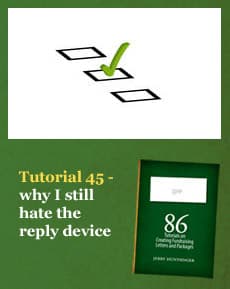Tutorial 45: why I still hate the reply device
I hated the reply slip from day one. As a young writer, I discovered that every marketing textbook demanded the reply device be created before the letter was written.
- Written by
- Jerry Huntsinger
- Added
- January 15, 2019

This never made sense to me. How could I come up with a great phrase until I had gone through the creative process of putting words on a page? And every writer knows that you often begin a letter at one level and suddenly your mind conjures up an image and the letter jumps ahead several levels. Shouldn’t those new insights be a part of the reply slip?
Well, that’s just one reason why I learned to hate the reply slip. Another reason was the restrictions. It had to be a certain size and provide a blank space for the donor’s name. (Remember when we used to put the label on a little crooked in order to draw attention to the donor’s name?)
Then the computer whizzos and donation processing companies came up with scanning marks and that further restricted creative input on the reply slip.
Finally came the age of disclaimers and the reply slip became cluttered with tax information and threatening messages from lawyers and information about financial reports. Most recently, a box has been added that you can tick if you don’t want your name to be rented, exchanged, or sold to a lonely hearts fan club.
So here I am today still hating the reply device. Not so much because I don’t feel that I really do a good job with it. But, you see, prospective donors have this irritating habit of reading my captivating copy, lingering over my full-colour graphics and examining the pretty little premium with one hand, while wiping a tear from the eye with the other hand.
Then, the pretty little premium is tucked away in a drawer and the rest of the package is heartlessly stuffed into the nearest waste container – that is, everything except the reply device.
This tiny innocent little slip of paper is put into a stack of ‘bills to be paid’. Then, a week, 10 days, two weeks, a month (?) later, it’s cheque-writing time and the little slip is there to remind the donor of the emotional turmoil provoked by the original letter. But darn it, how can a tiny slip of paper with a sterile headline rekindle the emotional dynamics of the original package?
It can’t. At least, not most reply slips I develop. You see, there are so many things I would like to test, but clients tend to get real nervous about changing the format of the reply slip.
For example, why does the reply device need to be this tiny deathly-white scrap of paper every time? Why not make it big, bold and beautiful? Why not make it a quick recap of the appeal in bold copy?
And why not attach it to the bottom of the letter and instruct the donor to return the entire piece of paper? Then, when cheque-writing time comes, there’s the letter itself staring the donor in the face.
And why not put some pictures on it? Why surrender to bureaucracy and let the financial disclaimer provide the only visual excitement?
Why not make the reply device a miniature of the appeal? A digest: a quick read and quick scan?
And why not provide adequate space to really spell out in detail all the benefits the donor is going to receive? And include a small photograph of the benefits?
Stop. Here’s advice from a marketing textbook. ‘The reply device is an agreement or contract between the donor and the charity. The reply device must clearly state the terms of the contract.’ Can you believe that garbage? Relax. I quoted myself. That word ‘contract’ is wrong. And without persuasion, the reply device is flat and lifeless.
And why give the prospective donor 17 different boxes to tick, all crammed together in type that requires a magnifying glass? Why doesn’t someone really test a long string of asks vs. two or three asks? Or a single ask?
Also, I like an old-fashioned reply card. It has more substance than a flimsy slip of paper. Oh sure, it costs more money to produce so I suppose it will never beat a prospect package roll-out with a standard reply slip. But it would be fun to test, wouldn’t it?
Yesterday I received an appeal from the Southern Poverty Law Centre the organisation co-founded by Morris Dees. His people do a lot of innovative work on their renewal series and it’s worth a $25 gift to get the SPLC material and study their techniques.
Anyway, the reply slip had a most interesting feature: the dollar amount boxes and copy used typewriter type that matched my name. And so the suggested gift amounts were somehow more, well, personal. Probably the computer programme called for a suggested gift representing an upgrade from the $100 level. But it made me feel good about the ask and connected my name with the boxes.
This small technique probably isn’t going to double the response – but it’s a start. (You may remember that a few years ago, the big thing was a computer-generated ‘personal’ message on the reply slip. This soon became common and obvious and, unfortunately, not well tested and rarely cost productive.)
In summary then, the reply device I would love to test would be an A4 sheet with the donor’s name and address displayed prominently at the top, a series of headlines and subheadlines, a choice of three gift items, photographs on the left, the donor ‘contract’ on the right, and instructions on how to use the reply slip at the bottom.
On the back – yes – more pictures! A positive, upbeat message from the chairperson, an endorsement from a celebrity and then, buried at the very bottom, all of the threatening legal and financial disclaimers with a little box to tick if it is okay with the donor that her name is swapped with another organisation.
© SOFII Foundation 2010-2014.

















